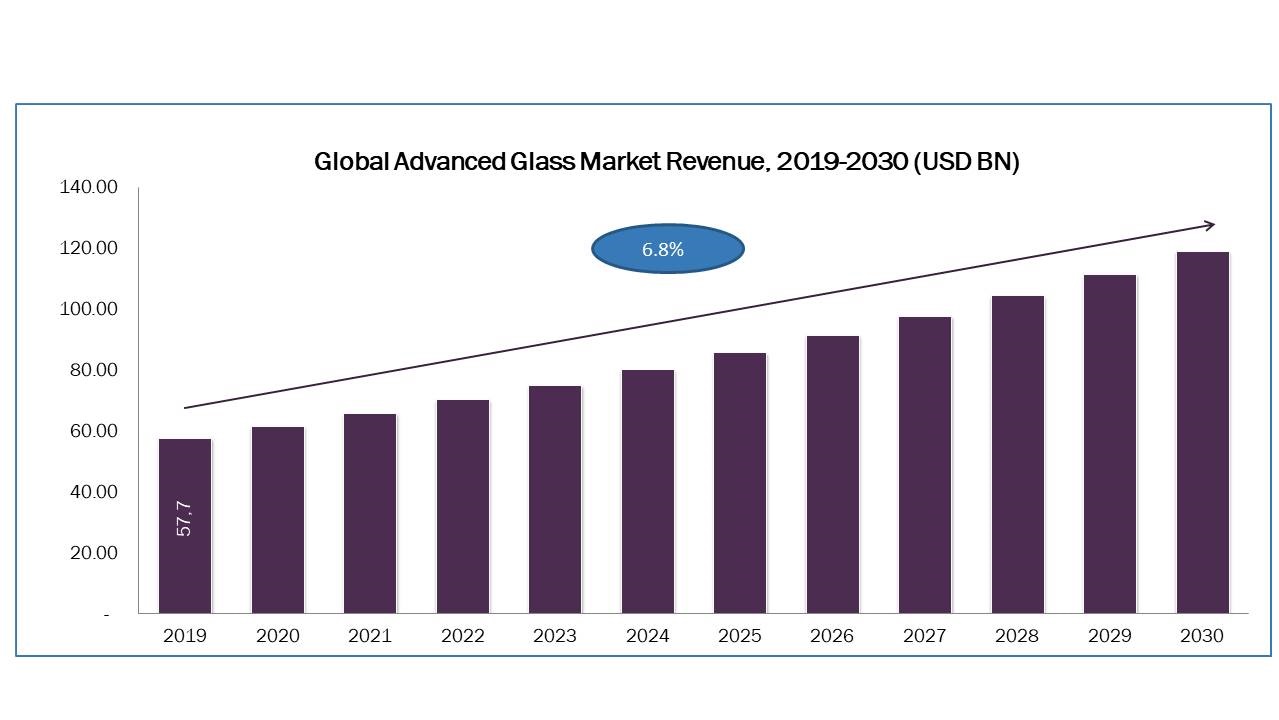Global Advanced Glass Market is expected to reach USD 118.1 billion by 2030
15-Jan-2025

The increasing demand for advanced glass in various industries, rapidly growing urbanization and rising government infrastructure projects across the world is driving the growth of advanced glass market.
The Advanced Glass Market was valued at USD 75.0 billion in 2023, and is expected to reach USD 118.1 billion by 2030, with a CAGR of 6.70% during the forecast period, 2024–2030. The global expansion of construction projects is driving the growth of the advanced glass market. As construction initiatives increase worldwide, there is a growing demand for advanced glass, renowned for its energy-efficient properties.
The construction industry's heightened focus on sustainable practices has elevated the preference for advanced glass, aligning with the trend towards environmentally friendly materials. The incorporation of advanced glass in construction not only improves energy efficiency but also contributes to better insulation, reduced energy consumption, and overall enhanced environmental performance. This trend is a key driver behind the flourishing advanced glass market.
Moreover, the increasing demand for advanced glass in diverse industries, such as automotive, electronics, and aerospace, highlights the growing acknowledgment of its unique properties and applications. Within the automotive sector, advanced glass is favored for its lightweight attributes and improved safety features, contributing to fuel efficiency and occupant protection.
Moreover, in the fields of electronics and aerospace, the distinctive optical and thermal characteristics of advanced glass are indispensable for applications like displays, sensors, and aircraft components. The expanding versatility of advanced glass underscores its crucial role in addressing the evolving technological and environmental requirements of various industries, fueling its escalating demand.
However, the glass manufacturing market's expansion is hindered by a significant obstacle stemming from its substantial carbon footprint. The energy-intensive characteristics of glass production, particularly the high-temperature melting of raw materials, play a substantial role in the generation of greenhouse gas emissions. This environmental consequence is now a central concern for consumers, regulatory bodies, and industries placing a high value on sustainability.
On the contrary, the introduction of smart glasses, such as electrochromic and thermochromic glass, provides dynamic control over transparency, tint, and light transmission, responding to external conditions or user preferences. The ability to adapt to changing environmental factors and user needs positions smart glass at the forefront of cutting-edge technology, with applications ranging from energy-efficient windows in buildings to adaptive automotive sunroofs.
This not only enhances the user experience but also brings about substantial opportunities for growth in the advanced glass market. As these smart glass technologies continue to evolve, they are poised to revolutionize various industries, driving the expansion of the advanced glass market.
Request for a Sample PDF on the Advanced Glass Market
According to the report, the key companies operating in the advanced glass market include Asahi Glass Co., Ltd., Saint Gobain S.A., Nippon Sheet Glass Co., Ltd., Corning Inc., GrayGlass Company, Schott AG, Advanced Glass & Mirror Inc., Guardian Industries, Sisecam Group, PPG Industries, Inc., Abrisa Technologies, Central Glass Co., Ltd., Euroglas GmbH, Fuyao Glass Industry Group Co. Ltd., Advanced Glass & Mirror Inc., and others.
Key Insights from the Construction Market Report:
-
The information related to key drivers, restraints, and opportunities and their impact on the advanced glass market is provided in the report.
-
The value chain analysis in the market study provides a clear picture of the roles of each stakeholder.
-
The market share of the players in the global advanced glass market along with their competitive analysis are provided in the report.
Add Comment
Related News
Roofing Tiles Market to Grow at 4.2% CAGR by 2030
Increasing construction activities across the globe, surging demand for advanced...
White Cement Market to Grow at 6.04% CAGR by 2030
Surge in the construction of public infrastructures such as flyovers, roads, rai...
Flame Retardants Market to Grow at 6.4% CAGR by 2030
The increase in the demand for Flame Retardants due to the stringent fire safety...







